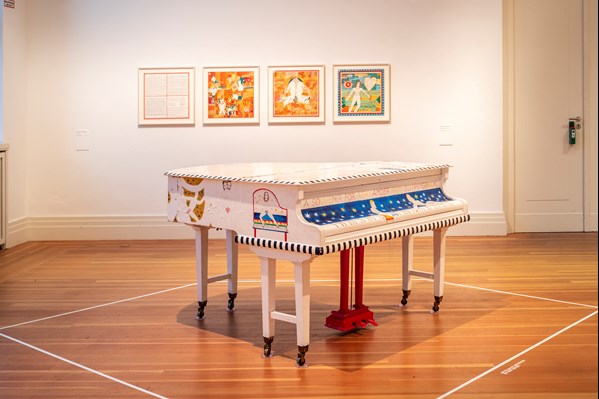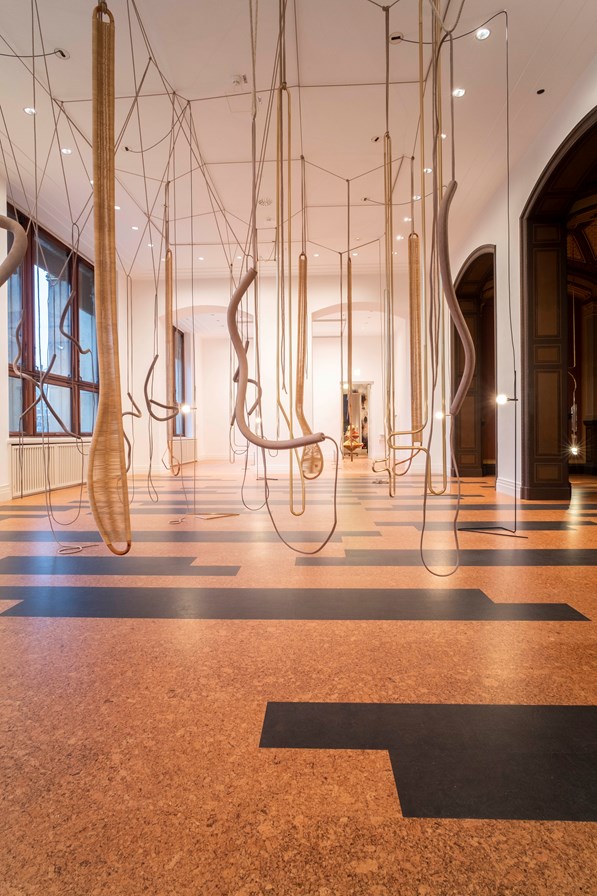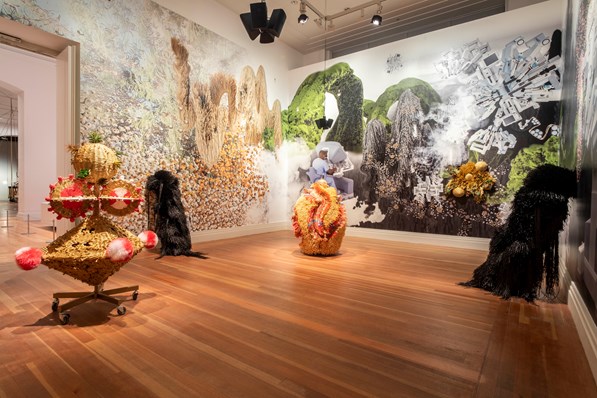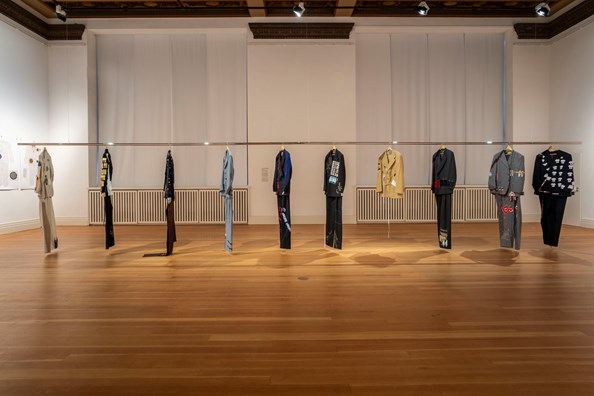
And Berlin will always needs you is at the Gropius Bau in German capital until the 16th of June and it is a compendium of Berlin based international artists. The title is inspired by Dorothy Iannone’s dedicated song to her friend Marz Harding in 1977 where she sang about her emotional attachment to Berlin.
Image: Dorothy Iannone, "A Souvenir for Ajaxander", 1989-1990; "Darling Duck", 1983-1984, Installation view And Berlin Will Always Need You. Art, Craft and Concept Made in Berlin, Gropius Bau, Berlin, 2019, Photo: Mathias Völzke, courtesy the artist, Air De Paris & Peres Projects, Berlin, Monika Frei-Herrmann, Cologne
And Berlin will always need you is at the Gropius Bau in German capital until the 16th of June and it is a compendium of Berlin based international artists. The title is inspired by Dorothy Iannone’s dedicated song to her friend Marz Harding in 1977 where she sang about her emotional attachment to Berlin.
The exhibition opens with a gigantic work by Chiharu Shiota (1972, Japan) an immersive and enveloping web composed by 780 km of white yarn and papers that are a reference to historical documents that relate to the early history of the exhibition house. The work is literally over our heads as we walk in the atrium of the Gropius Bau and it’s possible to perceive the amount of knowledge that has been presented, preserved and constantly rethought in this space.

Dorothy Iannone, "A Souvenir for Ajaxander", 1989-1990; "Darling Duck", 1983-1984, Installation view And Berlin Will Always Need You. Art, Craft and Concept Made in Berlin, Gropius Bau, Berlin, 2019, Photo: Mathias Völzke, courtesy the artist, Air De Paris & Peres Projects, Berlin, Monika Frei-Herrmann, Cologne
The work by Leonor Antunes (1972, Lisbon) follows and it refers to the works of pioneers of art and design history of the 20th century, such as weavings of the Bauhaus artist Anni Albers, or the wicker and wooden furniture of the Italian architect and designer Franca Helg. It is a reflection of traditional craft techniques and their historical uses. Suspended sculptures made from rope, copper, brass, leather, wood, nylon or rattan are composed by intersecting elements that change their appeal with the natural light entering from the big windows.
Katarina Šević (1979, Serbia) sees craft-manship as an essential part of ideologies, as a crafted product able to transport both political and economic aspects of history and society. Her work, News from Nowhere, 2018 refers to the title of the novel by William Morris (1834-1896), a British author and central figure in the Arts and Crafts movement. In his socially critical book, published in 1890, the protagonist awakens in an utopian socialist future where agricultural work and craftwork is supposed to guarantee a fulfilled life. With her series of 18 handmade wooden objects, dedicated to to crafts and its role in today’s society, Šević combines details of existing objects with self-conceived forms.

Leonor Antunes, "Franca (#4)", 2018, Installation view And Berlin Will Always Need You. Art, Craft and Concept Made in Berlin, Gropius Bau, Berlin, 2019, Photo: Mathias Völzke, courtesy the artist, Marian Goodman Gallery, Gallery Kurimanzutto & Galeria Luisa Strina
Haegue Yang (1971, Sud Korea) interweaves political narratives with materiality and ornamentation, creating objects and installations that are conceptually multilayered and sensually immersive. Her latest works combine various elements into a holistic, cognitive experience.The walls are entirely covered by organic images here and there interrupted by technical subjects and hairy sculptures are in the room as protectors of the installation.
Dorothy Iannone (1933, Usa) began to create paintings ad collages with decorative motifs and dense patterning in the early 1960s, drawing inspiration from literature, her initial field of study. While reading Shakespeare, Henry Miller and the poems by Wallace Stevens, figurative forms and erotic play began to make an appearance in her work. Affective, uncensored presentation of female desire and matriarchal power are depicted in her works. Iannone describes aspects of ornament and folklore as an investigation of the self, eros and cosmic union.
Haris Epaminonda, (1980, Cyprus) connects with history in order to examine the language of the object and how the perception of objects is changed by museum display. The work VOL.XXV is an installation resulting from her unique organisational system, by which she numbers sequentially. Different objects are disposed in the room generating a minimal scenography framed by the artist.

Hague Yang, Installation view And Berlin Will Always Need You. Art, Craft and Concept Made in Berlin, Gropius Bau, Berlin, 2019, Photo: Mathias Völzke, courtesy the artist & Galerie Barbara Wien, Berlin
Julieta Aranda (1975, Mexico) composes sensorial encounters with the nature of time and speculative literature. Working with installation, video and print-media, she is invested in exploring the potential of alternative economies and the ‘poetic of circulation’. The work Ghost Nets bring together 3D printing with analogue processes like ceramics, woodwork and Mexican tapestry weaving. The grid used is a leitmotiv alludes to modernist design.
Mariechen Danz, (1980, Dublin) questions received systems of knowledge starting from the human body. In her sculptures, performances and drawings emerge an understanding of knowledge that is not static, rather characterised by movement. In this case with Common Carrier Case: rotation route refers to ‘common carriers’ as media that transport knowledge and ‘case’ that implies bodies and systems giving house to symbols, signs, glyphs and gestures.
Nevin Aladağ (1972, Turkey) work is based on the intermingling of cultures and traditions within our society which she takes up not only with sculpturally but also with film, sound works and performances. In the series Social Fabric, the artist combines carpet fragments creating a colourful patchwork. Questions about the conditions of production of individual elements are raised here, as well as the topic of borders in our shrinking world.
Olaf Holzapfel, (1967, Germany) sees traditional knowledge and artisanal legacy as part of the present and the future. Particularly interested in how craft techniques can be traced back to natural forms, the artist searches for cultures that are connected to the use of natural materials. Working occasionally site specific, he develops works with the community as happened in Argentina. There he came across the cactus fibre Chaguar which has been used for textiles by the indigenous women of the Wichi community in northern Argentina over centuries.Theo Eshetu, (1958, London) spent several years of his childhood in Senegal ad Ethiopia and eventually lived in Rome. His personal experience of cultural hybridity has led him to consistently stitching together histories of African modernity and European imperialism. The result in an unique aesthetic that captures the interrelation of world cultures through videos.

Alice Creischer, Andreas Siekmann and the Brukman Workers, "Brukman Workers (10 Suits)", 2004-2006, Installation view And Berlin Will Always Need You. Art, Craft and Concept Made in Berlin, Gropius Bau, Berlin, 2019, Photo: Mathias Völzke, courtesy the artists & VG Bild-Kunst, Bonn 2019
Simon Wachsmuth (1964, Germany) investigates blind spots and unexpected epilogues in art history. In his work he uses archives and brings them into dialogue with minimalist forms. In Qing he choreographed a journey through time where the performer Loulou Omer dances in courtly robes amidst blue and white porcelain.
Willem De Rooij (1969, Netherlands) works with photography, film and installation in ways that challenge historiography, iconography and representation. His work questions similarities and contrast in intercultural exchanges, modes of perceptions, individuality and collectivity through the examination of pure materiality.
Antje Majewski (1968, Germany) questions the entanglement of nature and culture through painting, video and collaborative projects. Olivier Guesselé-Garai (1976, France) examines geometric abstraction in his painting and sculpture, and deploys a formal yet playful approach.Their joint installation dissolves the categories of art, crafts and cultural objects examining the transformation of meaning, function and value that emerges through the exhibiting, archiving and preserving of cultural objects from Cameron, since the time of European colonialism.
Alice Creischer (1960, Germany) Andreas Siekman (1961, Germany) and the workers of Brukman is a work about the occupation and the global economy's financial restructuring, which began in the 1990s and led to the crisis in Argentina. Their work is addressed to explore the political paradigm shifts market by the advancement of globalisation and neoliberalism since the 1990s.
The exhibition is rich of interesting material that shows a large variety of arts and crafts produced by international artists based in Berlin. Since the show will be closing soon, it is definitely time to go and explore the eclectic scenario.

ArtDependence Magazine is an international magazine covering all spheres of contemporary art, as well as modern and classical art.
ArtDependence features the latest art news, highlighting interviews with today’s most influential artists, galleries, curators, collectors, fair directors and individuals at the axis of the arts.
The magazine also covers series of articles and reviews on critical art events, new publications and other foremost happenings in the art world.
If you would like to submit events or editorial content to ArtDependence Magazine, please feel free to reach the magazine via the contact page.